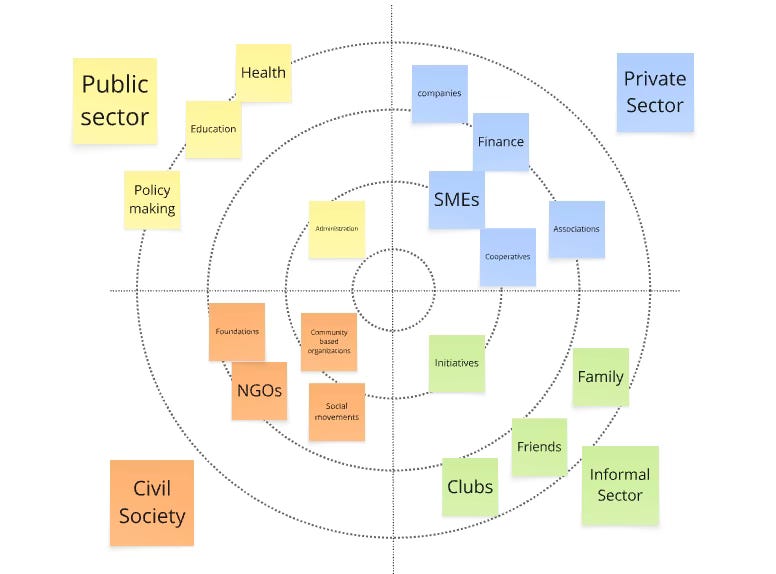Ask the Expert: How to map the Actor Ecosystem?
In all of our work, curating a productive set of actors for the system innovation process is key to success. Our mantra is: Everybody who needs to be part of the solution needs to be part of the process - and only those. In order to understand who are these actors, we start by mapping the ecosystem.
The process of the analysis can vary significantly, depending on how much information is desired and how well the system is already understood. If you are already familiar with the system, a short brainstorming session may be enough to sketch out the key actors and their connections. If you are exploring a new system, this typically requires research and interviews. Talking to system actors, we explore what motivates them, what they perceive as enablers and inhibitors, and how they relate to others. We get a sense of who has influence and power and who remains more at the margins. We also see which resources and capacities are currently weak or missing that could enable a shift to the desired system .
In our work, system mapping is usually the starting point for a co-creation process. The interviews thus also serve to engage participants, invite them to the process and hear what they need to join.
Mapping the ecosystem is a fairly straightforward process. And yet, it can end up being generic or not very insightful. How to get it right? We asked the expert.
Clau’s Insights
Endeva Associate Expert Claudia (Clau) Knobloch has led and overseen dozens of ecosystem mappings in sectors as diverse as entrepreneurship, energy, inclusive business, or green hydrogen in countries around the world.
Clau, what are success factors for mapping ecosystems?
It is important that everyone is included with an equally strong voice. Sometimes individuals have a specific agenda and try to influence who is represented. This might be interesting data but should not distort the mapping itself.
The more specific the boundaries are set, the better the mapping. The objective is always to clearly name all relevant actors. Otherwise the mapping becomes too generic.
Finally: don’t spend too much time on the mapping itself! Get everyone in the same room (physically or virtually) and start to collaborate. Lengthy preparation with individual actors is often not necessary.
What are challenges?
Mapping only works for existing systems. If a system is still very weak or emerging, the resulting map often remains quite generic and open. We often work on future systems that require new constellations of players. It is then the expertise, intuition and network of the curator (or client) that defines who is invited.
What makes a good map?
A strong ecosystem map highlights the specific actors in a given region and thematic area, shows which actors are most relevant, and also reveals gaps. To achieve this, different types of visualization are helpful:
A network map is useful for showing relevance and interconnectedness.
Matrices that indicate key dimensions (e.g. type of finance and stage of finance for a startup finance ecosystem) are better for identifying gaps (e.g., to reveal what kinds of funding are available, etc.).
Thank you, Clau!
This is the first tool we are publishing of the 20 we have in the book. with each tool, we provide a quick summary of steps and requirements. We also want to develop templates where useful. You can find them on our Miro board.
Steps
Define the objective and scope (e.g., using a research question or guiding star and regional boundaries)
List relevant actors. Map actors and their relationships. (This can involve desk research, interviews, etc.)
Interview actors about relationships, incentives, and dynamics. Add detail to the map.
Share the map with actors for feedback. Make adjustments accordingly.
What is it for?
Identify relevant actors and understand their interests
Illuminate relationships and dynamics between actors
Map roles and identify gaps
How long does it take?
Depending on the depth of analysis: from 1 hour to 1–2 months
Resources



